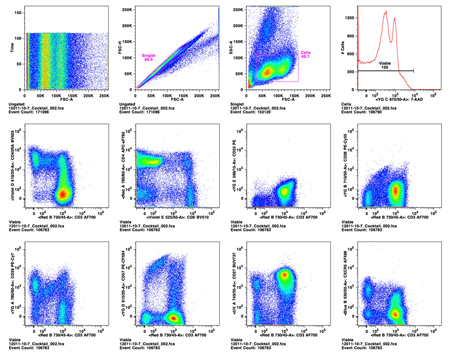Lymphoid malignancies characterization by large-scale multiparameter and high-dimensional modality analyses may uncover new cell subpopulation correlations with disease

Multiparameter flow cytometry data example showing a typical gating strategy and representative data analysis by two-dimensional pseudo-color dot plots.
Lymphoid malignancies are cancers of the immune system whose behaviors are highly dependent on the associated non-cancerous cells that help the cancer grow in its local environment. Our ability to study this local environment has been stymied by a lack of agnostic methodologies to quantitatively characterize the vast and complex repertoire of cells.
In collaboration with the laboratories of W. Richard Burack, M.D., Ph.D., Andrew G. Evans, M.D., Ph.D in the department of Pathology and Laboratory Medicine, Tim R. Mosmann, Ph.D., Sally Quataert, Ph.D., in the Center for Vaccine Biology and Immunology, and Clive S. Zent, M.D. in the Wilmot Cancer Institute, we are collecting large-scale multiparameter flow cytometry and mass spectrometry data on paired blood and lymphoid malignancy specimens. To analyze these large-scale multiparameter data sets in an agnostic high-dimensional manner, we will utilize the recently developed SWIFT (Scalable Weighted Iterative Flow-clustering Technique) algorithm that is ideal for identifying unique cell subpopulations within the lymphoid malignancy local environment.
Our long-term goal is to apply these technologies toward the identification of unique cell subpopulations found in the lymphoid malignancy local microenvironment that will aid in diagnosis and treatment of these cancers.